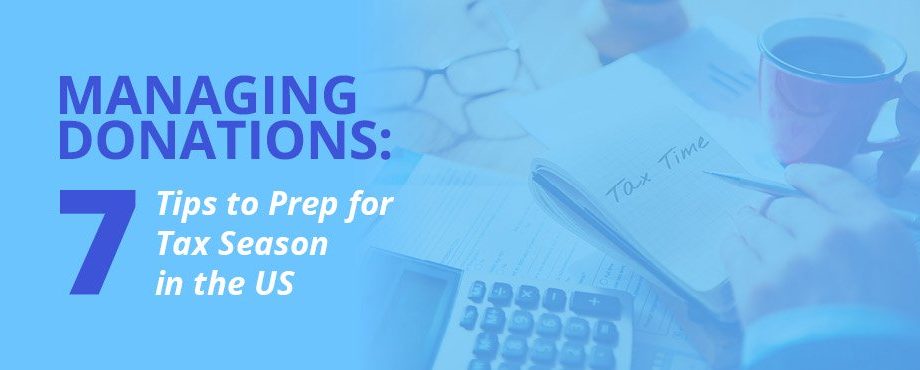Managing Donations in the US: 7 Tips To Prep For Tax Season

Your nonprofit relies on your successful fundraising plans to operate. These fundraisers help provide the cash you need to create effective programming and to spread the word about your organization. Not to mention the fact that it helps to have a little financial cushioning in the bank for your upcoming events or projects!.
Honestly, when you’re planning fundraisers, you’re probably not thinking about taxes. Rarely, if ever, do nonprofits think about tax season outside of the season itself. You’re more worried about raising enough money to support your mission, your latest project or program, and your upcoming auction. After all, these are the fun things to think about!
However, tax season is a real and important aspect of your nonprofits 501(c)(3) status.
Its important to remember the various aspects of your strategy that will make this upcoming tax season more successful, instructive, and smooth-sailing than in previous years. That’s why we put together this list of 7 important tips to remember as you prep for tax season throughout the fiscal year.
Your nonprofit works hard in your day-to-day fundraising campaigns, but often take a complete it and forget it approach. The funding you collect needs to be recorded and filed as a part of your annual tax forms. Lets dive in to learn more about how to tackle your upcoming tax season.
1. Understand the importance of tax forms
Almost all of the federal revenue comes from taxes. Taxation is how the government plans the budget and programming for the country. So they must have a good reason for allowing nonprofits to not pay these taxes on revenue!
Your nonprofits Form 990 helps explain to the government:
- The amount of tax-free money that moves in and out of your nonprofit.
- The purpose of your nonprofit and why you deserve to remain tax-exempt.
- The allocation of how you spent the revenue your nonprofit collected.
That’s why its important to the government that your nonprofit file your annual tax forms. However, the penalties invoked by the government for those who don’t file their forms ensure nonprofits, like yours, also take these annual forms seriously.
If your organization has gross receipts less than $1,000,000 for the tax year, your penalties could look like this for forgetting to file:
- A penalty of $20 per day the return is late.
- A maximum penalty of $10,000 or 5% of the organizations gross receipts (whichever is less).
Meanwhile, for nonprofits with gross receipts more than $1,000,000, your penalties for forgetting to file could look like this:
- A penalty of $100 per day the return is late.
- A maximum penalty of $50,000.
If your nonprofit sends a letter to the government explaining why you filed your forms late, you could have the fees waived. You could also fill out a Form 8868 to ask for a 6-month extension on the deadline. However, its way easier to simply file on time the first time.
Nonprofits who qualify for the 990-N and file their form late actually have no consequences, but if they fail to file for three consecutive years, that nonprofit will lose its tax-exempt status. Well talk more about which form your nonprofit should file in section 3.
2. Gather the relevant documentation you need
You’ve done this with your personal taxes before. The easiest way to ensure all of your information is correct is to gather the documents and organize your materials beforehand. This is especially true if you haven’t invested in an e-filer or an accountant to help you complete the form.
Take a minute to consider the type of information that’s included in the Form 990. You’ll need to compile information about the last fiscal year such as:
- How much fundraising revenue your nonprofit has collected
- Salary amounts for your employees
- The allocation of money spent on fundraising expenses
- Allocation of money spent on management costs
- And more
Luckily, this information can all be located within your nonprofits accounting software. Be sure to run reports such as your statement of functional expenses and statement of activities to have on hand while you file.
TIP: It also helps if these documents are preformatted to FASB standards to ensure all information is included this year, and consistent from year to year.
Form 990s and the documents required to file this document help improve transparency for your nonprofit. When you have information at your disposal regarding overhead, fundraising successes, and project expenses, you can better communicate it to your donors.
3. Know which tax form you should file
Different nonprofits qualify to file different versions of the 990. It all depends on the gross receipts of the nonprofit or total value of assets. The different forms your nonprofit could file are the 990-N, 990-EZ, or Form 990.
990-N
The 990-N, also called the 990 Postcard, is the lowest tier of Form 990. Its also the simplest to fill out. This 8-question electronic form is only available for those organizations with gross receipts less than $50,000 for the last fiscal year.
If you think your nonprofit may be eligible for this tax form, check out this educational article by File 990. It clarifies all of the additional eligibility requirements associated with the 990 Postcard.
990-EZ
The next tier of the 990 is the 990-EZ. We like to explain this form by saying the 990-EZ is like the Pepsi Zero to the IRS Form 990s Original Pepsi. This form is 4 pages with additional schedule pages that request supplementary information given specific circumstances.
Your nonprofit qualifies for the 990-EZ form if your organization has less than $200,000 in gross receipts or less than $500,000 in total assets.
We have another helpful article linked here for more information about the 990-EZ if you want to know more about your potential eligibility (or simply more about the form itself!).
Form 990
The general Form 990 is a 12-page form that must be filled out by nonprofits who have at least $200,000 in gross receipts or more than $500,000 in total assets.
If your organization falls into this category, don’t stress! While the 990-N and 990-EZ are simpler forms to complete, as long as you have all of your data well-organized, you shouldn’t have too much trouble.
4. Invest in an e-filing software solution
Do you invest in a tax filing software solution for your personal taxes? It makes it easier to ensure you’ve filled out the proper sections of the form and didn’t miss any important information.
Tax software for nonprofits does the same thing.
This software helps your organization ensure the form is complete, easy to fill out, and filed on time. Its especially important for smaller organizations who may not have the resources to hire an expert or the spare time in their schedules to wrestle with tax paperwork.
Easing the process of filing tax paperwork for nonprofits helps free up additional time that can (and should) be spent on projects enhancing the organizations mission.
5. Make sure you file on time
We understand nonprofits have a lot on their plates.
Your organization focuses on collecting details about the audience of your fundraising campaigns, marketing strategies, fundraising goals, and communication platforms. You chock your schedule full of various events, campaigns, projects, and more.
While many of you may think, Of course Ill file my information on time, the reality is that with so much on your schedule, its easy to forget.
We recommend marking your calendar, setting reminders on the calendar on your phone, and writing a sticky-note to put on your desk to remind yourself about the deadline for your tax forms just to be sure.
This deadline depends on the fiscal year of your organization. Your tax form deadline may either be:
- May 15th if your organization follows the calendar fiscal year.
- The 15th day of the 5th month after your fiscal year ends.
If you’ve invested in a comprehensive e-filer, be sure you set up notifications in the system so that it will alert you when its time to file again. In that case, you’ll be sent an email in addition to your reminders around the office.
6. Remember tax forms are public information
One of the most important things to remember as you file your tax information is that this data is all available to the public.
This makes your nonprofit tax information way different than personal tax data. Personal tax forms are between you and the IRS. However, nonprofit tax information is available to anyone who wants to see it. All a person needs is your organizations name or EIN to find it.
While your nonprofits fund accounting software has extensive features to report on anything you need to know about your nonprofit finances, only include the required and specified information on the form.
According to one study, nearly 1 in 5 nonprofits include and publish private social security numbers on public tax documents. Don’t be one of those organizations!
7. Take a minute to appreciate the numbers
As your nonprofit looks through your financial information in order to file your tax paperwork, its important to remember where you received the funding to handle those management, fundraising, and project expenses: your donors.
Step back and take a minute to appreciate the contributions that have been made throughout the last fiscal year in support of your organization.
True donor appreciation is necessary for maintaining or improving donor retention. That’s why its always a good idea to take a step back and realize that you couldn’t do the good work you do without their support.
Then, when it comes to taking steps throughout the year to show that appreciation, you can be sure its from a deep level of true gratitude.
If you’re looking for an idea as to how to show your appreciation for your valuable supporters, check out how to do our favorite example with this article about donor recognition walls from Double the Donation.
Tax season may seem daunting. We know you have a lot to do, and filing taxes is probably not the first item on your list of fun activities to complete for your organization. However, it is key for maintaining your tax-exempt status.
These 7 tips will help you navigate nonprofit tax season with ease! Plus, you’ll maximize the impact it can make for your organization when you’re prepared and grateful.
Guest blog by Ashton Green, File990
Tim Stansbury
Director and Fundraising Consultant
Tim joined Givergy in 2010, overseeing the early stage growth of the business to 50 employees across five international regions, supporting over 4,000 events worldwide. With a passion for leadership, business growth and exceptional standards, Tim is at the heart of all clients needs both in the UK and worldwide.
Benefit Auction Dos and Dont’s Every Fundraiser Should Know
April 11, 2025
Raffle Basket Ideas
April 11, 2025
What is a Chinese Auction (Tricky Tray Fundraiser)?
April 4, 2025
Fundraise Completely Free with Givergy: Here’s How
March 28, 2025
How to Run a 50/50 Prize Draw: The Easy Fundraiser That Delivers Serious Results
March 28, 2025

